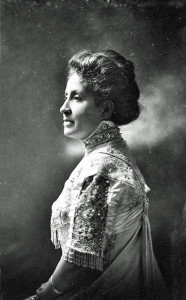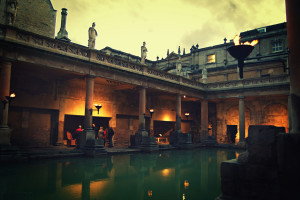Connie B. Dowell's Blog, page 2
May 8, 2015
Pythagoras and “His” Theorem
Due to some power outages, we’re a day late on this episode, but if you love math and science history, I hope we’ve made it up to you. Today we  discuss Pythagoras, the theorem he made famous but did not actually discover, and his hippie commune in Croton.
discuss Pythagoras, the theorem he made famous but did not actually discover, and his hippie commune in Croton.
We’ve got a list of recommended reading to be posted to this page shortly.
Image Credit: Peter Boothe, Flickr Creative Commons
April 27, 2015
April A-Z, Historical Photographs, Letters W through Z
This month we’re participating in the April A-Z blogging challenge. This page will be updated each day until we run through our letters for this batch, and then that’s the end of the challenge. I hope this brings some new history resources to light for you!
W is for Wagon Train
There’s no indication of where this picture was taken, but it was around 1905.
Three wagons and a lot of animals. I suppose there was a great deal to haul.
–Image Credit: Creator Unknown, Library of Congress Collection
–April 27, 2015
X is for Extraterrestrial
Are there photographs of historical space aliens?
Well, this guy did his best, but I’m still not convinced!
–Image Credit: Dick DeMarisco, New York World Telegraph & the Sun Newspaper Staff Photo, Library of Congress Collection.
–April 28, 2015
Y is for the Yukon River
Today we have a steamboat going down the Yukon around 1916.
It’s a shame the photo isn’t detailed enough to see the stars on the flag. There would have been only forty-eight.
–Image Credit: Unknown Creator, Frank and Frances Carpenter Collection, Library of Congress Collection
–April 29, 2015
Z is for Zeppelin
I can’t believe the month is over and literally over a thousand blogs have posted twenty-six posts each. 
And I saved a good one for last, a zeppelin under construction. Do you remember the scene in Indiana Jones and the Last Crusade where Indy and his dad ride in one? Don’t you wish we still rode these things like it was no big deal? I do.
Thanks everyone who participated in A-Z for your dedication. This has been a fun month.
–April 30, 2015
–Connie B. Dowell
April 23, 2015
April A-Z, Historical Photographs, Letters T through V
This month we’re participating in the April A-Z blogging challenge. Never fear, our regularly scheduled podcast episodes will still release every other Thursday. In between those episodes, enjoy some historical photographs themed to the letter of the day. This page will be updated each day until we run through our letters for this batch, and then we’ll start a new page with new letters. I hope this brings some new history resources to light for you!
T is for Turpentine
It’s sticky, it’s stinky, and if you grew up in southern Georgia, at some point your class was whisked away on a field trip to get a taste of life at the turn of the 20th century and and you had to look at lots of rusty equipment used to harvest it. 
Yet I don’t remember being shown any photographs of the actual harvesting on this trip. That might have caught some attention.
To be fair, though the field trip was interesting the first time the class went, but for some reason my school decided to make it a yearly outing. There’s only so many times a little kid can look at a stump and act enthused.
–Image Credit: B. L. Singley, Library of Congress Collection.
–April 23, 2015
U is for Umbrella
One more from the National Child Labor Committee Collection. 
The caption for this one is “This is the Day Nursery in the beet fields. Babies have to amuse themselves under the direction of those who are too small to work. Ordway, Colorado. Location: Ordway, Colorado.” Poor kids. I’m sure it was hot out there.
–Image Credit: Lewis Wickes Hines, National Labor Committee Collection, Library of Congress Collection
–April 24, 2015
V is for Vaccinations
This little girl is getting a typhoid vaccine in 1943.
Thank goodness for modern medicine. Because of vaccination efforts like this, we don’t worry about typhoid any more. Be sure to keep up to date on your vaccines (barring health reasons that would prevent you from doing so) so we don’t have a resurgence of terrible diseases.
–Image Credit: John Vachon, Farm Security Administration/Office of War Information Color Photographs, Library of Congress Collection.
–April 25, 2015
–Connie B. Dowell
Episode Seven: African-American Women’s Activism in the Progressive Era
Remember our episode a few weeks ago on women’s clubs? We’d promised to get a little more detailed on African-American women’s activism specifically, and today we’ve got it.
 Mary Church Terrell, first president of the National Association of Colored Women’s Clubs
Mary Church Terrell, first president of the National Association of Colored Women’s ClubsToday, it’s also just me, Connie, on the podcast. Stephen wasn’t able to record this time. He’ll be back for the next episode for sure.
If you’d like to learn more about these amazing ladies and what they did, check out the sources and links below.
Sources:
Busch, A. M. (2004). Lifting as we climb: The National Association of Colored Women’s Clubs. Gateway Heritage Magazine. 24(4), 1-6. Retrieved from http://collections.mohistory.org/media/CDM/gateway/72.pdf
Holland, E. (2010, February 1). Lifting as we climb: The women’s club movement [Blog post]. Retrieved from http://www.edwardianpromenade.com/african-american/lifting-as-we-climb/
Schneider, D. & Schneider C. J. (1993). American women in the progressive era. New York, NY: Facts on File.
Wormer, R. (2002). National Association of Colored Women. Retrieved from http://www.pbs.org/wnet/jimcrow/stories_org_nacw.html
P.S.: That last source has a link to read an address to the NACW by Mary Church Terrell.
Further Reading:
Comic about Ida B. Wells by Kate Beaton
Image Credit: Washington Area Spark, Flickr Creative Commons
April 20, 2015
April A-Z, Historical Photographs, Letters Q through S
This month we’re participating in the April A-Z blogging challenge. Never fear, our regularly scheduled podcast episodes will still release every other Thursday. In between those episodes, enjoy some historical photographs themed to the letter of the day. This page will be updated each day until we run through our letters for this batch, then we’ll post this week’s episode, and then we’ll start a new page with new letters. I hope this brings some new history resources to light for you!
Q is for Quack
Did you know the Library of Congress Prints and Photographs Online Catalog has things labeled “Quacks and Quackery”?
And here’s a genuine quack and his quack machine, according to the Library of Congress. This guy is Dr. Richard R. Schleusner and his machine was supposed to restore youth. I guess you stand on the pedal-like things and put the cup-like devices on your ears, perhaps?
–Image Credit: Arthur Kennedy, Library of Congress Collection
–April 20, 2015
R is for Railroad Car
…specifically a health car, which search engines constantly mistake for a misspelling of healthcare. 
I wish the quality of this photo was a bit better. I’d love to see more of what happened in the health car. It looks like there are medicine bottles at the edges. Was one of these guys a doctor or pharmacist?
–Image Credit: Creator Unknown, Frank and Frances Carpenter Collection, Library of Congress Collection
–April 21, 2015
S is for Sewing Class
Here’s one class that (unlike the blacksmithing) you might still find in a a school today. I took one as a teenager, and–surprisingly–there was still a fair amount of handsewing, just as the girls are doing here.
These girls are in Point Barrow, Alaska sometime between 1900 and 1930. They are learning to sew at the northernmost point of the United States (though Alaska was not yet a state when this picture was taken.).
–Image Credit: Creator Unknown, Carpenter Collection, Library of Congress Collection
–April 22, 2015
–Connie B. Dowell
April 16, 2015
April A-Z, Historical Photographs, Letters N through P
This month we’re participating in the April A-Z blogging challenge. Never fear, our regularly scheduled podcast episodes will still release every other Thursday. In between those episodes, enjoy some historical photographs themed to the letter of the day. This page will be updated each day until we run through our letters for this batch, then we’ll start a new page with new letters. I hope this brings some new history resources to light for you!
N is for Needlework
Today’s picture is of a 15-year-old, Helen Whitty, in 1917. It’s part of a collection of photographs of child laborers.
Image Credit: Lewis Wickes Hine, National Child Labor Commitee Collection, Library of Congress Collection
–April 16, 2015
O is for Oklahoma City High School
Today we have another photograph from the National Child Labor Committee Collection, but this one seems to fall under the category of vocational training.
There’s little information, but I suppose metalwork was a class at Oklahoma City High School in 1917. How would you have liked to do that as an elective?
Image Credit: Lewis Wickes Hine, National Child Labor Committee Collection, Library of Congress Collection.
–April 17, 2015
P is for Plein Air Painting
And today is a beautiful day for it. I might have to go out, at least with a sketchbook if not paints.
Plus, many national parks are open free of charge this weekend, including Shenandoah National Park where the lady in the picture painted around 1940.
–Image Credit: Jack Delano, Library of Congress Collection
–April 18, 2015
–Connie B. Dowell
April 13, 2015
April A-Z, Historical Photographs, Letters K through M
This month we’re participating in the April A-Z blogging challenge. Never fear, our regularly scheduled podcast episodes will still release every other Thursday. In between those episodes, enjoy some historical photographs themed to the letter of the day. This page will be updated each day until we run through our letters for this batch, then we’ll start a new page with new letters. I hope this brings some new history resources to light for you!
Nope, that’s not a UFO, it’s a tetrahedral kite and that guy way far in the right is Alexander Graham Bell. He didn’t just do the telephone. Learn more about Alexander Graham Bell and aviation here.
Image Credit: Creator Unknown, Library of Congress Collection
–April 13, 2015
L is for Laboratory
Eek! I missed a day, but I am making up for it with both L and M this morning.
So that’s high school chemistry in the 1890s. Looks much fancier than my high school was.
Image Credit: Frances Benjamin Johnston, Library of Congress Collection
–April 15, 2015
M is for Mail
Today is Tax Day in the U.S., but I’m sure we’ve all turned everything in already, right?
Well, if you haven’t, be sure to submit your return electronically or visit someone like this guy by the end of the day.
Image Credit: Creator Unknown, National Photo Company Collection, Library of Congress Collection.
–April 15, 2015
–Connie B. Dowell
April 9, 2015
April A-Z, Historical Photographs, Letters H through J
This month we’re participating in the April A-Z blogging challenge. Never fear, our regularly scheduled podcast episodes will still release every other Thursday. In between those episodes, enjoy some historical photographs themed to the letter of the day. This page will be updated each day until we run through our letters for this batch, then there will be a podcast episode and we’ll start a new page with new letters. I hope this brings some new history resources to light for you!
H is for Hand-Colored
This photo almost went under G for Gardens, but I couldn’t resist spotlighting the hand-coloring all on its own.
Whether done by watercolors, pencils, pastels, or ink, this is a look that’s always intrigued me, somewhere between not realistic enough and a little too realistic. I’d love to do a book cover in imitation of the style someday.
–Image Credit: Frances Benjamin Johnston, Library of Congress Collection
–April 9, 2015
I is for Ice
Shackleton and his crew had one heck of a job. I’m not sure at what point during the Endurance expedition this is, but boy does it look like an intense moment.
Image Credit: Underwood & Underwood, Library of Congress Collection
–April 10, 2015
J is for 4th of July 1905
Imagine having this as your 4th of July entertainment.
The original caption from the Library of Congress reads “The daring ride of Mrs. Eunice (Winkless) Padfield, July 4th 1905.” She seems like a lady with a fascinating story.
Image Credit: C. E. Holmbloe, Library of Congress Collection
–April 11, 2015
–Connie B. Dowell
April 8, 2015
Episode Six: Take a Western Bath!
No, we’re not talking cowboys. Today we’re talking Western cultures’ bathing traditions (or lack thereof for certain historical periods).
 The City of Bath, U.K.
The City of Bath, U.K.What was ancient bathing like? (Our resident classicist, Stephen, draws from his wealth of knowledge on this one.) When did bathing fall out of favor and why did it come back? What is the sham beast? Find out on this week’s podcast.
Bonus announcement: This podcast is now available on Stitcher! It will, of course, continue to be available on iTunes as well.
Connie’s Sources:
Fuller, A. (2001). The beauty of bathing: Throughout history bathing has been one of civilization’s great pleasures, but there were long periods when it fell out of fashion. Cosmetics, 29(2), 56.
Worsley, L. (2011). If walls could talk: An intimate history of the home. New York, N.Y.: Walker & Company.
Worsley L. (Writer), & MacGregor, H. (Director). (2011, April 20). The bathroom [Television series episode]. In. E. Hindley (Producer), If walls could talk: The intimate history of the home. London, United Kingdom: BBC Four.
Shampoo [Def.1] (n.d.) Online Etymology Dictionary, Retrieved from http://etymonline.com/index.php?term=shampoo&allowed_in_frame=0
Shampoo [Def.2] (n.d.) Online Etymology Dictionary, Retrieved from http://etymonline.com/index.php?term=shampoo&allowed_in_frame=0
Stephen’s Recommended Reading (As he spoke from his background knowledge on the topic, this is not a source list.):
Websites:
http://www.romanbaths.co.uk/
http://www.reshafim.org.il/ad/egypt/timelines/topics/cosmetics.htm
Books and Articles:
The Genesis of the Roman Public Bath: Recent Approaches and Future Directions by Garrett G. Fagan in American Journal of Archaeology
Vol. 105, No. 3 (Jul., 2001), pp. 403-426
Baiarum Grata Voluptas: Pleasures and Dangers of the Baths by Katherine M. D. Dunbabin in Papers of the British School at Rome
Vol. 57 (1989), pp. 6-46
Harry B. Evans, Water Distribution in Ancient Rome (University of Michigan Press, 1994, 1997)
Cicero, Ad Atticum
William Smith Roman Baths (Balneae) from “A Dictionary of Greek and Roman Antiquities”, pub. John Murray, London, 1875.
Epistulae morales ad Lucilium 56.1, 2, Seneca the Younger.
Invisible Romans, Chapter 1, Robert C. Knapp.
The Economy of Prostitution in the Roman World, Thomas A.J. McGinn, Ann Arbor: The University of Michigan Press, 2004.
Roman Britain by Guy de la Bedoyere.
Daily Life in Ancient Egypt by Don Nardo
Bath-Tubs in Ancient Greece by J. M. Cook in Greece & Rome, Vol. 6, No. 1 (Mar., 1959), pp. 31-41
Videos:
Roman Bath: a day at the baths. An interactive site using the Baths of Caracalla as an example. (From PBS’ NOVA series).
Image Credit: Ignacio Garcia, Flickr, Creative Commons





